Shrubs or trees to 4-5 m; trunks 15-20 cm diam. Stem segments linear to narrowly obovate, some-times slightly falcate, (10-)15-35(-50) × 5-15 cm; areoles 2-3+ cm apart, 2-5 mm diam.; wool tawny, whitening with age. Spines usually absent or 1(-3), particularly on older pads, straight or curved, brown, aging gray, stout, to 2 cm. Glochids inconspicuous. Flowers 4-7 cm; inner tepals spatulate; crowded pink filaments and white style much longer than tepals, to 15 mm; nectar chamber elliptic to obconic. Fruits ellipsoid, 25-40 × 20-25 mm; areoles well distributed. Seeds tan to gray, 3-5 × 1.5-3 mm, slightly pubescent. 2n = 22 (Mexico, Puerto Rico as an escape).
Flowering winter (Sep-Mar). Hammocks, fields, sandy soils; 0 m; introduced; Fla.; Mexico; West Indies (Cuba, Puerto Rico); Central America (Panama).
The stem segments, or pads, of Nopalea cochenillifera are used as food, fodder, and poultices, and for rearing cochineal insects to obtain a red dye (once a major industry). This species may have been selected for spinelessness in Mexico, much like Opuntia ficus-indica, to ease the culturing and collection of cochineal scale insects for red dye.







